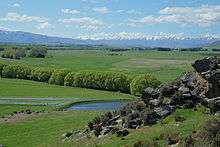Saint Bathans Fauna

The Saint Bathans Fauna, or St Bathans Fauna, is found in the lower Bannockburn Formation of the Manuherikia Group of Central Otago, in the South Island of New Zealand. It comprises a suite of fossilised prehistoric animals from the late Early Miocene (Altonian) period, with an age range of 19–16 million years ago. The layer in which the fossils are found derives from littoral zone sediments deposited in a shallow, freshwater lake, with an area of 5600 km2. The lake was bordered by an extensive floodplain containing herbaceous and grassy wetland habitats with peat-forming swamp–woodland.[1] At that time the climate was warm and the surrounding vegetation was characterised by casuarinas, eucalypts and palms as well as podocarps, araucarias and southern beeches. The fossiliferous layer has been exposed at places along the Manuherikia River and at other sites in the vicinity of the historic gold mining town of Saint Bathans. The fauna consists of a variety of vertebrates, including fish, a crocodilian, a rhynchocephalian (a relative of tuatara),[2] geckos, skinks, and several kinds of birds, especially waterbirds.[3] Of tree-dwelling birds, parrots outnumber pigeons thirty to one.[4] A basal form of kiwi, Proapteryx, is known from there.
Mammals
Uniquely in regards to modern New Zealand's dearth of land mammals there is a basal theriiforme mammal, the Saint Bathans mammal.[5] Several species of mystacine bats are also known, as well as a vesper bat and several incertae sedis species.[6] This suggests that small land mammals were a common component of New Zealand's fauna in the Miocene, with even bats being significantly more diverse than today.
Palaeognaths
New Zealand's two modern palaeognath clades, the kiwis and moas, have early representatives in the Saint Bathans fauna. The former is represented by the diminutive, possibly volant Proapteryx. The latter is represented by several bones and egg shells of currently unnamed species, but already identifiable as true moas, being large sized and flightless.[7][8] The fact that moas are already recognisably modern in anatomy, and possibly ecology, while kiwis are fairly unspecialised and probably still flighted, confirms the previous suspicions that neither clade is closely related and that they arrived in New Zealand independently: moas arrived and became flightless earlier in the Cenozoic, while kiwis were then recent arrivals.[9]
Parrots
A strigopoidean genus, Nelepsittacus, is represented by at least four species. These vary drastically in size, suggesting that they occupied a wide variety of ecological niches, having diversified in the absence of other parrots.[10]
Pigeons
Two pigeon species have been described. Rupephaps is a large fruit pigeon, possibly related to the modern Hemiphaga species. The Zealandian dove is similar to the Nicobar pigeon.[4]
Passeriformes
A New Zealand wren, Kuiornis indicator, is known from these deposits, possibly similar to the modern rifleman.
Herons
At least two herons are known: Pikaihao bartlei and Matuku otagoense. The former is a bittern, while the latter is a much larger species that appears to be basal within Ardeidae.
Herpetofauna
The Saint Bathans fauna is rich in reptile and amphibian remains. Several groups present in modern New Zealand are represented, such as leiopelmatid frogs, a sphenodontian similar to the modern tuatara, geckos and skinks. However, there are also several species not seen in modern-day New Zealand, such as a mekosuchine crocodile and pleurodire and meiolaniid turtles. All in all this suggests that New Zealand's herpetofauna was much richer in this epoch, rather fittingly as its climate was considerably warmer than today.[11]
References
- ↑ Worthy TH; Tennyson AJD; Jones C; McNamara JA; Douglas BJ (2007). "Miocene waterfowl and other birds from central Otago, New Zealand" (PDF). Journal of Systematic Palaeontology. 5 (1): 1–39. doi:10.1017/S1477201906001957.
- ↑ Jones MEH; Tennyson AJD; Worthy JP; Evans SE; Worthy TH (2009). "A sphenodontine (Rhynchocephalia) from the Miocene of New Zealand and palaeobiogeography of the tuatara (Sphenodon)". Proceedings of the Royal Society B. 276 (1660): 1385–1390. doi:10.1098/rspb.2008.1785. PMC 2660973.
- ↑ Scofield, R. Paul; Worthy, Trevor H. & Tennyson, Alan J.D. (2010). "A heron (Aves: Ardeidae) from the Early Miocene St Bathans Fauna of southern New Zealand.". In W.E. Boles & T.H. Worthy. Proceedings of the VII International Meeting of the Society of Avian Paleontology and Evolution (PDF). Records of the Australian Museum. 62. pp. 89–104.
- 1 2 Guildford, Jonathan (8 May 2018). "Newly-discovered pigeon species related to the dodo lived in NZ millions of years ago". Stuff. Retrieved 8 May 2018.
- ↑ Worthy, Trevor H.; et al. (2006-12-19). "Miocene mammal reveals a Mesozoic ghost lineage on insular New Zealand, southwest Pacific". PNAS. Retrieved 2007-08-23.
- ↑ Hand, SJ; Worthy, Trevor H.; Archer, M; Worthy, JP; Tennyson, AJD; Scofield, RP (2013). "Miocene mystacinids (Chiroptera, Noctilionoidea) indicate a long history for endemic bats in New Zealand". Journal of Vertebrate Paleontology 33 (6): 1442-1448.
- ↑ Worthy et al. 2007
- ↑ Tennyson, Alan J.D., Worthy, Trevor H., Jones, Craig M., Scofield, R. Paul & Hand, Suzanne J. (2010). "Moa's Ark: Miocene fossils reveal the great antiquity of moa (Aves: Dinornithiformes) in Zealandia". Records of the Australian Museum, 62 (1): 105–114.
- ↑ Worthy, Trevor H.; et al. (2013). Miocene fossils show that kiwi (Apteryx, Apterygidae) are probably not phyletic dwarves (PDF). Paleornithological Research 2013, Proceedings of the 8th International Meeting of the Society of Avian Paleontology and Evolution. Retrieved 9 March 2014.
- ↑ Worthy, Trevor H.; Tennyson, Alan J. D.; Scofield, R. Paul (2011). "An early Miocene diversity of parrots (Aves, Strigopidae, Nestorinae) from New Zealand". Journal of Vertebrate Paleontology. 31 (5): 1102–16. doi:10.1080/02724634.2011.595857.
- ↑ Trevor H. Worthy, Terrestrial Turtle Fossils from New Zealand Refloat Moa's Ark, Copeia 2011(1):72-76. March 2011. DOI: 10.2307/41261852